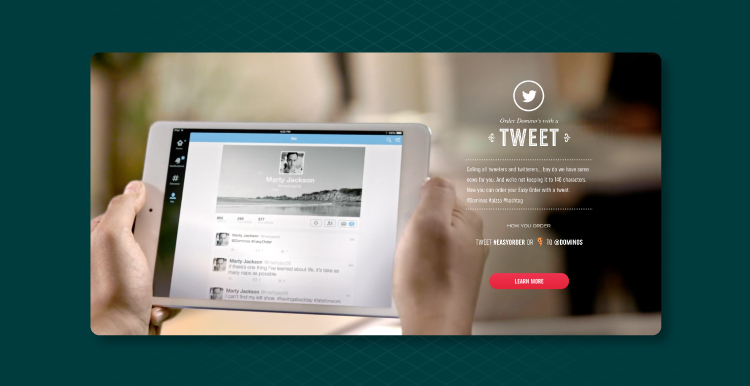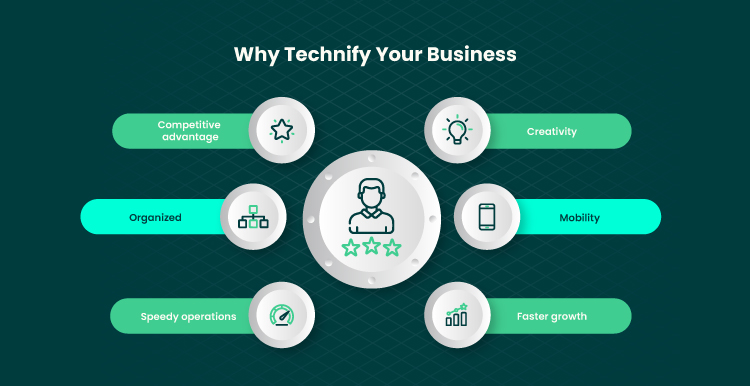Business technology has been rapidly changing the world for years. Market research shows that these are not tech companies only that have found business technology vastly improving their efficiency. 52% of companies worldwide report an increase in worker productivity, 49% — better performance, and 46% — better customer experience after digital renovation.
We have compiled a list of bright stories and case studies on how technology in business helped improve KPIs and achieve better returns. Enjoy!
Domino’s Pizza
Context: Domino’s Pizza is one of the biggest pizza restaurant chains in the world. This is an international business operating in more than 83 countries. The business started its journey pretty successfully. In 2007, the stock price of Domino’s Pizza was $32.25. This was a good rise compared to $14.70 in 2004. But in 2008, things started to change. Domino’s experienced a steady decline. In October of the same year, their stock price was only $5.95. The team started to look for ways to revamp the business and grow again.
Challenge: Drop in demand and decrease in popularity. Domino’s Pizza had to transform their service delivery and bring more value to customers.
Solution: Domino’s team understood that making tasteful pizzas is not enough in the competitive environment. Technology and business had to be brought together to produce extra value. This value would help the company stand out and immediately attract client attention. The team knew that if you offer customers a better service at the same price, they will choose you over the competitors. This was the point when Domino’s turned into a tech-savvy company. Business technology was one of the tools that helped the business fight crisis. They started to integrate business technology to improve agility.
The company’s concept of Domino’s Anyware enables clients to order their favorite pizza via dozen of channels. This makes it very convenient for people to make an order regardless of where they are. Namely, you can order via Smart TV, Facebook Messenger, Alexa, and even Twitter! Twitter is probably the most impressive and unusual place to make orders. But it works. And here is how:

Domino’s Pizza makes this possible with the help of Artificial Intelligence and Machine Learning. Smart chatbots integrated into different digital channels process big volumes of data. They are also capable of automating order fulfillment. All you need to make use of Domino’s Anyware is to have your Pizza account registered. All the information, including the one about your favorite orders, will be automatically extracted from the account. Chatbots enable users to place and track their orders, speed up order processing, and improve the service based on client feedback.
When the pandemic attacked humanity, Domino’s also found a way to adjust. They offered the so-called Carside Delivery option. It is the delivery method that enables clients to choose a side of the car where their order will be delivered. If, for instance, a customer sits in the front seat, the delivery person will put the order in the back seat.
Value: How does technology help business? Let’s see. With technology, Domino’s has become a company delivering multi-experience client service. Customers truly enjoy the convenience that Domino’s offers. The opportunity to order pizza nearly anywhere makes the business a part of a customer’s daily routine. Clients see the presence of the business in many channels. This sets a robust connection with the audience. Figures point to great results, too. This year, Domino’s increased their stock price to $396.96.
Michelin
Context: Michelin is the second largest tire manufacturer in the world. The company has a long history. It was founded more than 130 years ago. Since then, Michelin carries their best practices and values through time. Yet, the tech advancements of modern times don’t allow such a big business to stand aside. The company’s goal is to grow and self-improve together with their clients. As vehicles get smarter and more advanced, the businesses that serve car owners’ needs should keep pace with them as well.
Challenge: Stay competitive in the age of smart manufacturing and production.
Solution: Michelin decided to build an effective digital growth strategy with three focus areas. First, streamline and speed up business operations. Second, offer a personalized experience to their B2B clients and end users. Third, use technology to build new business strategies and models.
The company has an R&D department that constantly looks for ways to bring innovation to their business. Researchers extensively test AI capacities to streamline manufacturing and improve client experience. AI-powered data circulation across different areas of business enables the Micheline team to accelerate decisions and build a performant collective business intelligence all departments can rely on. What’s more, the company uses collaborative robots that automate routine jobs, save time, and alleviate the workload.
Value: With top-notch technology, Michelin reaches better ROI, gets more safety and comfort, and improves performance. AI-powered data storage, visualization, and the creation of new models allow the team to spend fewer physical resources on testing. They can test a new service delivery model with the software, create digital twins, and anticipate cost-prohibitive issues. This, in turn, reduces the risks and leads to more precise decision-making.
Walmart
Context: As a leading retail giant, Walmart has a deep sense of market changes and the importance of technology for business. The need to transform the way clients interact with the brand became evident to Walmart’s team. Moreover, the company had enough capabilities to invest in digital transformation and upgrade back-office operations.
Challenge: Bring innovation, fight competition, and digitize the shopping experience.
Solution: The challenge of the use of technology in business had two sides. On the one hand, Walmart wanted to renovate the services they deliver to a customer. On the other hand, the team needed to revamp the way they run management, administration, and other in-house processes. In 2018, Walmart invested more than $11 billion in tech renovation. As a part of their business growth strategy, they decided to partner with leading tech companies. These were Google (voice-enabled commerce) and Microsoft (cloud computing).
Because of the changing consumer demands, Walmart also decided to strengthen their social media presence. Omnichannel retailing was a strategy for reaching a millennial audience and fully satisfying their needs. As for the back-office innovations, these included the modernization of the supply chain and inventory management. This enabled the company to lower the costs and service prices by optimizing and balancing them in various digital channels. AI-powered data analytics integrated into their supply chain solutions give the company access to data about a customer. Understanding client needs helps them to adjust their marketing effort and make data-driven decisions.
Walmart invested in Data Café, the data storing and management hub that processes data collected from more than 20 000 Walmart stores and more than 200 internal sources. In Data Café, Walmart data experts visualize, manipulate, and interpret data for faster decision-making and better ROI. The company also integrated artificial intelligence technologies for business as well as blockchain. This improved the traceability of products down the supply chain.
This is how the company’s digital transformation looked from the tech side:
Value: Walmart digitized their supply chain management, CRM, marketing and sales, and other aspects. This enabled the company to reach efficiency and reduce expenses. Faster inventory processing reduces time to market and enables the team to diversify client experiences. Walmart becomes a highly technological company with most of the processes running digitally.
Nike
Context: Nike is one of the leading apparel manufacturers that always put innovation and client comfort in the first place. This is rooted in the very mission of the company and the digital transformation strategy they follow. When the pandemic started, the company fully realized the need to go digital and work on online audience engagement. The team saw the gaps that had to be covered to build a robust ecommerce strategy.
Challenge: Update the ecommerce strategy so that online retail becomes a robust revenue channel.
Solution: In 2017, Nike decided to move away from wholesale and build a strategy for directly connecting with their clients. Direct access to the target audience has become a priority for Nike’s team. The decision to exit wholesale was tricky as 80% of Nike’s profit came exactly from it. Other businesses probably wouldn’t take such a risk. But Nike did. The company’s desire to differentiate itself pushed them to build and improve their digital channels.
To increase the significance of Nike’s digital channels for a user, the brand needed to build an ecosystem. Like Apple’s example, Nike used the capacity of business technology to build applications that extend the company’s services. These are Nike Run Club and Nike Training Club apps that can be downloaded to mobile devices:

Users of these apps get access to various training programs. They become members of Nike’s community. Clients now think of the company not as a retailer but as a brand cultivating a healthy lifestyle and making perfect clothes and footwear for doing sports.
Value: Ecommerce sales of Nike were estimated at 43% today. Though, the company expects them to reach 50% by the end of the year. Understanding client needs that go beyond primitive shopping habits lies at the core of Nike’s recent success. The company managed to integrate business technology into building a direct and personalized connection with their audience.
Tesla
Context: From the very beginning, Tesla knew how to use technology in business to stand out. Tesla was not among the typical industry representatives. The positioning of the brand included transformational and innovative ideas. The bunch of benefits the company offers to the audience impresses. Tesla cars are highly innovative, eco-friendly, future-proof, and easy to maintain. How does Tesla manage to achieve such a great result? With effective technology, of course.
Challenge: Use top-notch technologies to redefine the way people see cars and their functions.
Solution: Tesla is the only car manufacturer in the world that introduces software updates over the air. To get safety, performance, or convenience updates, a client doesn’t need to put effort. The manufacturer automatically improves the vehicle’s characteristics and capacities. All you need to do is to download a software update using Wi-Fi and launch the installation.
What’s more, a person doesn’t have to visit a showroom to purchase a car. The company uses online channels to enable online car purchases across the globe. As in the case of the pizza ordered from Domino’s, you can fill in the form and order a Tesla car. Such a simple approach to sales simplifies the way one has to go through to decide if they need a new vehicle.
Sure, the opportunity to visit a showroom and run a test drive is available. This automotive company also plans to integrate AR technology into the manufacturing process. AR is expected to ensure quick data access for manufacturers across the factory. The workers will easily get the images they need in front of their eyes to ensure an uninterrupted and smooth production chain process.
Tesla regularly introduces new interesting features to their infotainment software system. There are popular apps integrated into the system. These include streaming platforms and video portals like YouTube, Netflix, or Hulu. What’s the most exciting is that you can turn the arcade mode on and use your steering wheel buttons for game navigation. Sure, this function is unavailable when driving. But as soon as you park the car, you can enjoy the multi-dimensional experiences that the smart vehicle gives you.
Value: For Tesla clients, the company has turned from a car manufacturer only to a brand with a consistent mission and significant impact on the market. Tesla Motors managed to set an uninterrupted connection with their audience. By offering unique opportunities for clients, they got rid of the need to have a mediator between them and their customers. Tesla directly influences the audience. This reduces the time needed to present a product to the market.
Besides, the company transformed people’s view of the function of cars. In addition to primitive values like transportation ability, a car has become a place where you enjoy a high comfort level and entertainment opportunities.
What About Small Businesses?
Hearing success stories of well-known brands is truly inspiring. But what if you are a small-size company that plans to grow and digitize? We would say that it’s even better. When you are on the market for a long time, it’s harder for you to revamp your processes in the company. It’s hard to teach people to work differently and to teach clients to perceive your business and your values differently. This is why growing businesses can digitize their operations with fewer risks and losses.

The use of technology in businesses is a win-to-win solution. You can perform many types of work and roles with technology. If you want to conduct a full-scale digital transformation, contact our team and we will do it together. If you are wondering what to start with, we’ll give you a few ideas of useful software tools that can upgrade and modernize your work.
- Project management software. If you have several teams that deal with different processes, a project management tool can be a useful addition to the communication software you use. It helps managers to track everyone’s activity daily, assign new roles and tasks to remote workers, set goals and plans, track progress, prevent delays, schedule video conferencing, etc.
- CRM system. A custom relationship management system enables marketers and sales departments to manage their customer information and relationships with clients digitally. With such software programs, you’ll know when it’s the right time to get in touch with your clients not to lose them.
- HR management system. Such a system is used for managing work schedules, time offs, sick leaves, announcing important dates, etc. You’ll keep track of how your company grows, how many teams you have and what team composition is, and much more. Combining HR systems with management information systems can give you clues on how to improve your organization’s key metrics.
- E-signature tools. A perfect choice if your employees work remotely. Such tools enable your team to sign documents and agreements online. All you need is to create an electronic signature in such a tool and provide your email address to sign and receive documents.
- Accounting and automated reporting software. Managing incomes, taxes, invoices, and automated generation of reports is possible with accounting systems. You’ll reduce the workload of your accountants, prevent fraud, and eliminate mistakes in calculations.
- Password management tool. More and more people choose this type of software. There’s no need to worry about the security of all your accounts. A password management system allows you to store all your passwords safely in one place and ensures the safety of remote work.
- Data backup software. A secure data backup tool allows you to protect your data in case of a system vulnerability or crack.
Let the Journey Start
In this article, we explained how technology helps business growth. No matter how big your business is, there are plenty of ways new tech can help you grow. For big enterprises, investing money in full-scale IT renovation can be a way to become more efficient and performant. For small business owners that plan to grow, digitizing their business function will also mean process optimization and more opportunities to scale up.
Forbytes is a software product engineering company with cross-industry experience in the business world. We can help you customize the software to fully meet your needs or build a solution from scratch. Our products are user-oriented and capable to prepare your business for tomorrow.
Contact Forbytes if you think that we can create team synergy and push you towards better ROI.








